62 Heads
Drum Head Authority posted a grrrreat article on drum tone — probably the most-useful to-date —
Drumheads: More important than drum wood
We’re covering drumheads first, because drumheads are by far the biggest factor in your drum sound.
Out of everything, the drumheads you choose (and what you actually do with the heads) will contribute to the vast majority of your drum sound.
(Sidenote: that’s actually why DrumheadAuthority was created… we’re a 100% free resource to help you find the right drumheads.)
The best way to illustrate this point is to show you. The video below has 62 different drumheads, all played on the same drum.
All heads were tuned to the exact same tension, recorded with the exact same mics, and the drum is always the same Yamaha Absolute Maple Hybrid 14″x6″.
…
It’s easy to see why many drummers say 80% of your drum sound comes from the drumheads alone. Even changing from a clear to a coated version of the same head will make a difference to your sound.
Now, think back to the four recordings you listened to earlier, with the birch, oak, maple, and cherry wood drum kits. How different did each of those kits sound? Compare that to some of the drumheads in the video above: Some heads change the drum sound completely. It’s extremely hard to say the same about wood.
…
The basic rule behind all of this is quite simple: The more density and “stuff” that weights your drums down (or that chokes the vibration), the less sustain and low-end you’ll have.
…
If you want to maximize sustain and get a big boomy sound, go for light and small hardware that doesn’t choke the drum. If you want to reduce sustain or get a brighter sound, look for the opposite.
A drum makes sound by vibrating. If there’s too much hardware stuck to the shell, the drum will vibrate less. Similarly, if there are legs directing the vibration right into the floor, the drum will vibrate less.
…
Want another experiment? Listen to the difference in sound (especially sustain) when your tom is resting on a snare stand, versus when it’s mounted to the bass drum. There’s a huge difference, especially if you tighten the snare stand so it grips the tom hard. The three mounting points on a snare stand will choke that drum, compared to mounting it on the bass drum.
…
The way the drum is built will play a huge role in how the drum sounds. So much so, that companies can use the exact same wood for a drum but can end up with extremely different results.
Details like the orientation of each ply (which direction the woodgrain runs), how evenly the wood is cut, how it’s bent into a shell, and many many other factors will influence how well a drum can sing.
The ply count and the thickness of each ply are extremely important to your drum sound:
- Thinner shells give more sustain, they’re more sensitive to lighter playing, and they’re also quieter.
- Thick drum shells need to be hit harder to create a full sound, and the thickness can reduce the drum’s sustain.
Stave shells can sound very different to ply shells, partly because ply shells use a huge amount of glue (which chokes the sound) compared to staves.
…
Bearing Edges: More important than drum wood
Bearing edges are a critical point of contact between the drumhead and the drum. When you pay attention to how they work, you’ll quickly see why they matter a lot more than the drum’s wood type.
Bearing edges transfer vibration between the drumhead and the drum’s shell. They also help the drumhead sit tightly and evenly across the drum, and the way they’re cut will affect how the head vibrates (and how the drum sounds).
Bearing edges are cut on an angle. For reference, here’s a really simple overview:
- A sharper bearing edge angle (with less wood touching the drumhead) means you’ll have a brighter overall sound.
- A flatter angle (giving a wider area for the drumhead to touch) means you’ll have a warmer and softer overall sound.
The drumhead is less free to vibrate when it rests on thicker, flatter bearing edges, which can choke some of the higher frequencies (making the drum sound warmer) and can reduce the sustain.
Bearing edges are often completely overlooked when drummers are shopping for a new kit. The way they’re cut has more of an impact than the wood type though, so don’t ignore them.
It’s worth mentioning that really cheap drum kits can often have sub-par bearing edges (not exactly “damaged”, but just poorly cut and with less quality control), which can start to harm your sound.
and the drumhed comparison video
0:17 Diplomat M5
0:24 Diplomat skyntone
0:41 Calftone
0:50 Diplomat M7
0:59 Diplomat fiberskin
1:41 J1
1:50 Ambassador renaissance
2:07 UV1
2:40 Power center reverse dot
2:49 Controlled sound
3:21 Genera
3:30 Power stroke 3
3:47 Genera dry
4:12 Ambassador vintage
4:54 HD
5:03 HD dry
6:19 Pinstripe
6:52 Power stroke 4
7:04 Power stroke 77
8:01 EC reverse dot
8:26 Heavyweight
Don’t miss this —
